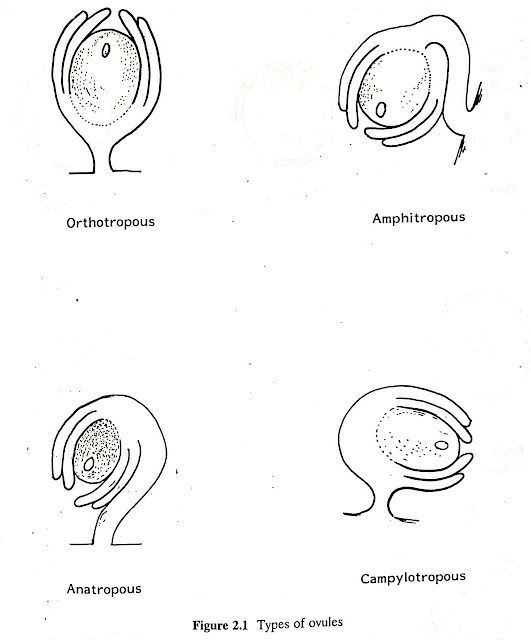Gametogenesis - Spermatogenesis - Oogenesis
Gametogenesis
Reproductive
mechanism:
In addition
to two vegetative and protective parts, the calyx and corolla, the flower has
two reproductive parts. They are the stamens (male = androecium) and carpel or
pistil (female = gynoecium). Stamens usually consist of a long filament and an
anther. The anther has two lobes, each containing two chambers (anther sacs).
It produces a large number of pollen grains with a haploid number of
chromosomes. The carpel consists of the stigma, style, and ovary, an enlarged
basal part having one or more ovules attached to the placentae in its cavity.
Contents
of Gametogenesis:
1.
Introduction
to gametogenesis
2.
Types
of gametogenesis (spermatogenesis and oogenesis)
3.
Spermatogenesis
(process, cells involved, and outcome)
4.
Oogenesis
(process, cells involved, and outcome)
5.
Stages
of gametogenesis (mitosis, meiosis, and differentiation)
6.
Mitosis
(definition and significance in gametogenesis)
7.
Meiosis
(definition, stages, and significance in gametogenesis)
8.
Differentiation
(definition and process in gametogenesis)
9.
Importance
of gametogenesis in sexual reproduction
10. Genetic diversity in offspring
11. Inheritance of genetic material from
parents
12. Conclusion
Introduction
to Gametogenesis:
Gametogenesis is the process by which
haploid gametes, which are sex cells, are produced from diploid cells. It is a
fundamental process of sexual reproduction in both plants and animals, which
involves a series of cell divisions and differentiation events. In this blog,
we will discuss gametogenesis in detail, including the types of gametogenesis,
the stages of gametogenesis, and the importance of gametogenesis in sexual
reproduction.
The stamen
consists of one filament, two anther lobes containing two pollen sacs each
(four total), and a connective tissue. The pollen sacs may be one-chambered
(monothecous), two-chambered (bithecous) or, rarely, four-chambered
(tetrathecous). After meiotic division of the pollen mother cells, a large
number of pollen grains are produced. On maturity, the anther lobes burst open,
forming a pore through which the pollen grains are released.
Types of
Gametogenesis:
There are
two types of gametogenesis: spermatogenesis and oogenesis. Spermatogenesis is
the process by which sperm cells are produced in the testes of male animals,
while oogenesis is the process by which egg cells are produced in the ovaries
of female animals.
Spermatogenesis:
Spermatogenesis
begins at puberty and continues throughout the life of a male animal. The
process involves the division of spermatogonia, which are diploid cells, into
spermatocytes, which are haploid cells. These haploid cells then undergo
meiosis to produce spermatids, which mature into sperm cells. The final outcome
of spermatogenesis is four mature sperm cells from each spermatogonium.
Oogenesis:
Oogenesis is
a more complex process than spermatogenesis and involves several stages of cell
division and differentiation. It begins before birth and is completed after
puberty in females. In oogenesis, diploid cells called oogonia divide into
primary oocytes, which are diploid cells that remain arrested in prophase I of
meiosis until puberty. After puberty, a small number of primary oocytes are
selected to continue meiosis and develop into secondary oocytes. During this
process, the secondary oocyte undergoes meiosis II to produce a mature ovum and
a polar body.
Stages of
Gametogenesis:
Gametogenesis
involves several stages, including mitosis, meiosis, and differentiation.
Mitosis:
Mitosis is
the process of cell division that produces two identical daughter cells from
one parent cell. During mitosis, the parent cell divides into two identical
daughter cells, each with the same number of chromosomes as the parent cell.
Meiosis:
Meiosis is
the process of cell division that produces haploid cells from diploid cells. It
involves two rounds of cell division, resulting in the production of four
haploid cells. Meiosis I involves the separation of homologous chromosomes,
while meiosis II involves the separation of sister chromatids.
Differentiation:
After
meiosis, the resulting haploid cells undergo differentiation to become mature
sperm or egg cells. In males, sperm cells undergo a process called
spermiogenesis, during which they develop into mature sperm. In females, egg
cells undergo a process called oogenesis, during which they develop into mature
ova.
Importance
of Gametogenesis in Sexual Reproduction:
Gametogenesis
is a crucial process in sexual reproduction, as it ensures genetic diversity in
offspring. During meiosis, homologous chromosomes exchange genetic material,
resulting in new combinations of genes in offspring. This genetic diversity is
essential for the adaptation and survival of species in changing environments.
Moreover, the process of gametogenesis ensures that offspring inherit half of
their genetic material from each parent, resulting in genetic variation in the
population.
Pollination:
The transfer
of the pollen grains to the stigma is known as pollination. Insects, animals,
wind, and water are the main agents of pollination. Pollination is of two
types. 1) Self-pollination or autogamy is transfer of the pollen grains of a
flower to the stigma of the same flower or flowers of the same plant. 2)
Cross-pollination or allogamy is transfer of pollen grains to the stigma of
flowers of another plant. In nature, cross-pollination is very important and
prevalent. Self-pollination also occurs in nature, but usually in cultivated
plants like wheat, rice, and cotton most of the progenitors are
cross-fertilized. Many plants have evolved special devices adapting them to
cross-pollination. On the other hand, the small flowers of the pea, peanut
(groundnut or moong phali) and Oxalis do not open up at all (cleisto gamy),
thus ensuring self-pollination.
Embryo
sac:
One or more ovules develop on the placentae
inside the ovary. A cell from the nucellus enlarges itself and undergoes
meiosis to form four megaspores with a haploid number of chromosomes. Three of
these degenerate, and the nucleus of the survivor divides mitotically
into two
parts, one of which moves to the upper and the other to the lower pole. Each
nucleus divides twice more, increasing the number of nuclei to eight, four in
each of two groups. One nucleus from each group moves towards the centre, and
both fuse to form one nucleus with a diploid number of chromosomes (n+n = 2n).
This is called the definitive nucleus. The three nuclei at the micropylar end
enclose themselves with a thin wall, forming the egg apparatus; while the other
three at the chalazar end form the antipodal cells. The egg apparatus is the
ovum or oosphere, the female gamete. The remaining two cells are called
synergids or helping cells. On fertilization, the egg cell gives rise to the
embryo, and the synergids disintegrate. Similarly, the antipodal cells have no
function and disintegrate. On fertilization, the definitive or secondary
nucleus forms the endospermic nucleus, developing into the endosperm of the
seed with a triploid (=3n) number of chromosomes. Types of ovule. The following
four types of ovule are found (Figure)
1. Orthotropous
(straight):
The ovule is erect or
straight, and its funicle, chalaza, and micropyle lie in one vertical line,
e.g. Polygonum (hazardani), walnut, pepper, and spinach.
2. Anatropous
(inverted):
The ovule bends back
along the side of the funicle so that the micropyle comes close to the hilum,
micropyle, and chalaza, but not the funicle, which lies in the same straight
line; this is the commonest form of ovule.
3. Amphitropous
(transverse):
The ovule is placed
transversely, at right angles to its funicle, as in Chenopodium (bathu).
4. Campylotropous
(curved):
The ovule is
transversed and bent like a horseshoe. The micropyle and chalaza are not in a
straight line, e.g. peas, beans, and radishes.
Conclusion:
Gametogenesis
is a fundamental process in sexual reproduction, which involves the production
of haploid gametes from diploid cells. The two types of gametogenesis are
spermatogenesis, which produces sperm cells in males, and oogenesis, which
produces egg cells in females. Gametogenesis involves several stages, including
mitosis, meiosis, and differentiation. The process is crucial for genetic
diversity in offspring, ensuring the survival and adaptation of species in
changing environments.







0 Comments